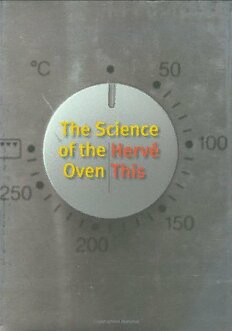
The Science of the Oven (Arts and Traditions of the Table: Perspectives on Culinary History) PDF
02009·0.406 MB·English
Most books are stored in the elastic cloud where traffic is expensive. For this reason, we have a limit on daily download.
Preview The Science of the Oven (Arts and Traditions of the Table: Perspectives on Culinary History)
Description:
Mayonnaise "takes" when a series of liquids form a semisolid consistency. Eggs, a liquid, become solid as they are heated, whereas, under the same conditions, solids melt. When meat is roasted, its surface browns and it acquires taste and texture. What accounts for these extraordinary transformations?The answer: chemistry and physics. With trademark clarity and wit, Herve This launches a wry investigation into the chemical art of cooking. Unraveling the science behind common culinary technique and practice, Herv? This breaks food down to its molecular components and matches them to cooking's chemical reactions. He translates the complex processes of the oven into everyday knowledge for professional chefs and casual cooks; demystifies the meaning of taste and the making of flavor; describes the properties of liquids, salts, sugars, oils, and fats; and defines the principles of culinary practice, which endow food with sensual as well as nutritional value.For fans of Herv? This's popular volumes and for newcomers to his celebrated approach, The Science of the Oven fuses the physiology of taste to the molecular structure of bodies and food, expertly expanding the possibilities of the kitchen. (10/31/09)
See more
The list of books you might like
Most books are stored in the elastic cloud where traffic is expensive. For this reason, we have a limit on daily download.
